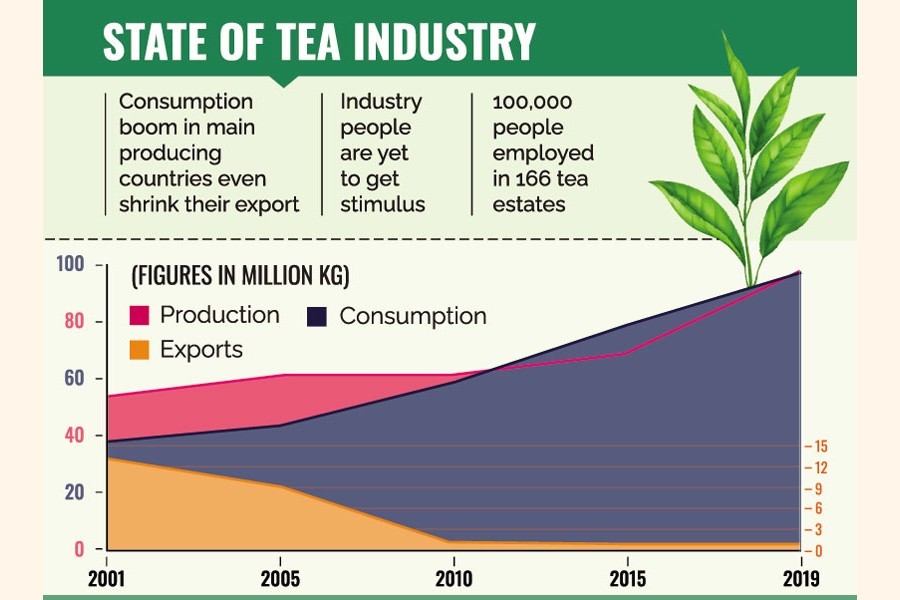Amid an unimpeachable surge in consumption over the decades, Bangladesh's 170-year-old tea industry bearing a British-era myth now fights a heroic battle to generate surplus for exports.
The agro-industry's expansion to its virgin land at the country's north tip comes as anew blessing. Sources say this stride to cope with the domestic demand and save for export trade sees tea plantation in unconventional areas like the northern zone which now has had 10 per cent of the national output share.
Although the rise in consumption boosts the sector as a whole, experts suggest combined public-private drive to enhance the export potential.
In 2019, the tea production of the country was 96.07 million kilograms against a consumption of 95.20 million kg, leaving only 0.60 million kg for export.
Back in 2001, the consumption was only 36.95 million kg and the production was 53.15 million kg when the export was 12.29 million kgs of tea.
In 2020, Bangladesh produced 86.39 million kgs of tea and exported 2.17 million kgs as consumption squeezed due to curbs stemming from the Covid pandemic.
As normalcy is returning now, with people coming out from confines, the consumption will rise again, lowering the availability for export, apprehend industry-insiders.
Under the scenario appearing on the horizons, raising the productivity is imperative to boost production, opined experts in the field.
According to scientists at Bangladesh Tea Research Institute (BTRI) tea cultivation in the country has experienced a bulging rise in productivity in the last decade.
The productivity ratio is over 2500 kg per hectare at present whereas it was around 1100 a hectare six or seven years ago, Director of the BTRI Dr Mohammad Ali told the FE.
They suggest introduction of modern cultivation method and new varieties to ensure higher surplus for exports.
The productivity can be raised manifold through introduction of new varieties, a senior scientist of the BTRI told the FE.
He informed that BT-22/23-variety plant, cloned by the BTRI, can produce over 3000 kg per hectare. "Similarly, we have produced a BTS-5 seed which has the same capability."
But people associated with the industry said that it is not easy to replace old one with new varieties.
It is easier for new gardens. It requires around 5 years for plants to mature. So uprooting existing plants to introduce new variety is not always feasible, a gardener explained.
Commenting on the issue Chairman of Bangladesh Tea Board Major-General Md Ashraful Islam said that the government has been providing major support to the tea sector which is evident in the recent decade.
"We are helping development of new tea estates in areas where tea cultivation was not done before. We have taken a number of projects to develop tea states in northern districts and in Chittagong hill tracts," he said about the expansion plan.
"We have a number of ongoing projects aimed at extending small-holding tea cultivation by organising and motivating the farmers. Under these projects we provide suitable technologies and financial support to the small tea growers under the programme and to train the small growers of tea and the executives involved with the implementation of the project for capacity building and skill development," Mr Islam mentioned.
Tea-processing factory is being also set up in the project area under this plan.
He appeared very optimistic about fulfilling the target to raise tea production to 140 million kgs by 2025 in line with the roadmap for the tea industry devised by the Board in 2017.
Interestingly, tea consumption is rising in many tea-producing countries, creating a shortfall in surplus for exports.
In China, annual production doubled over the decade to 2.61 million tonnes in 2018-some 44 per cent of the world output. But the availability for exports declined to 14 per cent from 22 per cent of 2009.
A major contribution to the growth in the production in recent times is made by northern tea planters.
Interestingly, before 2000, people in these areas could not imagine that teagarden could be established in that part of the country. Gone are those days--now gardens in Panchagar, Thakugaon, Nilphamari, Dinajpur and Lalmonirhat produce 10 million kgs of tea, which is 10 per cent of the country's total turnover.
Since 2000, tea cultivation has also been introduced in other parts of Bangladesh, namely, Panchagarh, Lalmonirhat, Thakurgaon, Nilphamari, Dinajpur and Bandarban in the Chittagong Hill Tracts.
The Bangladesh tea industry has seen continuous growth in production since the country's independence in 1971.
According to Bangladesh Tea Association, this industry provides direct employment to over 100,000 people in 166 tea estates.
The tea industry provides livelihood to 0.5 million people directly and as many indirectly who depend on the tea industry through tea trading, tea brokerage, tea warehousing and other ancillary service industries, says the Association.
However, many gardeners alleged that though the government had announced stimulus package for the sector, they were yet to get the benefit due to 'bureaucratic tangles'.
"I am still waiting," says one.


